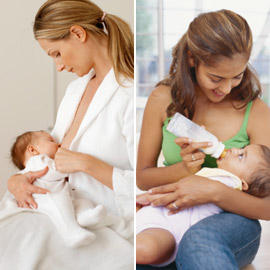Breastfeeding
Doctors, midwives, and even manufacturers of baby formula agree that breastfeeding is best for both you and your new baby. For this reason, I encourage you to give it a try.

No sooner has the pain of labor subsided and you’ve been handed your beautiful new baby, than your responsibility as chief provider for this new life kicks in. almost the first thing any doctor will do once your baby is born and has been checked over, is put him or her to your breast and ask you to start feeding.
The optimal length of time to breastfeed a baby is for six to 12 months. But even if you manage only a few weeks, I urge you to start out by breastfeeding because nature has formulated the best food – and food-delivery system – your baby could ever want.
Why Breast is Best
It’s all very well people telling you (and they will) that breast is best, but what exactly are the reasons?
Complete nutrition Your breast milk contains not only nutrients but also ingredients that can never be replicated in infant formulas, such as antibodies to arm your baby’s undeveloped immune system. Breast milk also contains the perfect ratios of certain ingredients (for example, the ratio of iron to protein), whereas in formula milk these ratios are out of balance. Your breasts also have the ability to manufacture milk at a rate that is attuned to your baby’s ever-changing needs.
Digestibility Breast milk is perfectly designed for a baby’s developing digestive system, and its protein and fat content is more easily handled by the baby’s gut than the protein and fat in formula milk. This means that breastfed babies tend to be less likely to suffer from colic, gas, and vomiting.
Antibodies Colostrum, which is the sticky “pre-milk” that makes up your baby’s first feed, is full of antibodies that can protect him or her from infection and disease. Breast milk itself protects your baby from constipation, allergies, and obesity and makes his or her bowel movements sweeter smelling.
Convenience Breast milk is not only completely cost- and bottle-free, it’s something you always have with you. In addition, you will deliver it at exactly the right temperature, making it hassle-free, too.
Faster recovery for you As well as providing closeness, which aids the bonding process between mother and baby, breastfeeding will help your uterus shrink back to its pre-pregnancy size more quickly (this shrinking causes the cramping sensation you may feel when your baby breastfeeds) and will help you shed leftover pregnancy weight because you have to burn calories to produce breast milk. In addition, breastfeeding forces you to stop during the day, encouraging you to sit down and rest while you feed the baby.
All this isn’t to say that there aren’t any advantages to bottle-feeding. Choosing to use a bottle, or having to use one if you’re unable to breastfeed, allows you more freedom (perhaps to spend time with the baby’s siblings and even for an evening out), makes it easier to monitor your baby’s intake of food, and gives the baby’s father an opportunity to enjoy the feeding process and bond with his baby, too. Bottle-feeding may also be less stressful in public.
Because of the evidence to promote breastfeeding, choosing not to breastfeed – or not being able to – can cause some women to feel immensely guilty. However, if something isn’t right for you – and that includes breastfeeding – then it won’t’ be right for your baby. A bottle given by a relaxed, happy, and loving mother is preferable to a breastfeed given by a mother who is stressed and unhappy.
How do you produce milk?
Your milk is produced in cells called alveoli in your breasts. It travels down the milk ducts and collects in sort of reservoir. The hormones prolactin and oxytocin control milk production by causing the milk-producing cells in your breasts to contract, squeezing milk down the ducts and out of your nipple. This is known as the “let-down reflex”, and it can be so effective that sometimes your breasts feel as though they are going to burst, and you look forward to feed time as much as your baby.
First steps with breastfeeding
First , let’s debunk some myths. Contrary to popular belief, you can breastfeed if you have small breasts or flat nipples. Breasts and nipples of all shapes and sizes can satisfy a baby, and the size of your breasts has nothing to do with the amount of milk you produce. And contrary to another popular myth, breastfeeding doesn’t ruin your breasts or affect their shape or size. Only hereditary factors, age, poor support and weight gain during pregnancy can make your breasts less firm after childbirth.
Don’t expect to have a breast full of milk right away. Babies are not hungry when they’re born, and it isn’t until the third or fourth day that your milk will start to come int. this doesn’t mean your breasts are empty. The first, pre-milk feeds are of colostrum, and each will average less than half a teaspoon. Even so, these tiny feeds give you baby all the nourishment and antibodies he or she needs to keep healthy.
When your milk does come in, your baby will be ready for his or her first “proper” feed. Have a glass of water just before you begin and make yourself comfortable. Your baby needs to be facing you so that he or she has to tilt their head back to get your nipple in their mouth, but experiment to find a feeding position that works best for you.

